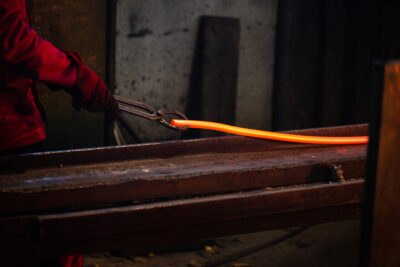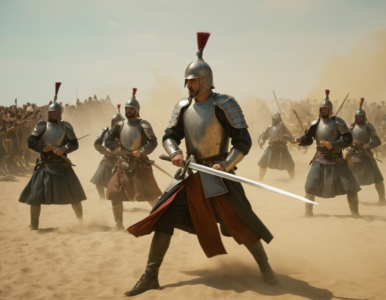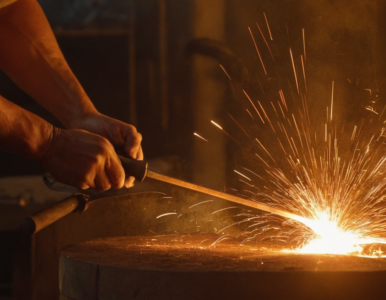Blog
Iron vs Steel Swords: Structure, History, and Metallurgy

Sword: A Weapon Forged Through Time
The sword, an image of force and polish, has been an ally to humankind for centuries. Its process started in the Bronze Age (3rd millennium BC – 1200 BC) with short, utilitarian blades crafted from bronze. As innovation advanced, iron swords arose during the Iron Age (1200 BC – 500 Promotion), offering more noteworthy strength and taking into account longer, more adaptable plans. The Medieval times (500 Promotion – 1500 Advertisement) saw a thriving of swordsmanship with the improvement of pot steel, prompting notable European swords like the Viking swords and equipping swords. While the appearance of explosive in the fifteenth century moved the concentration to guns, swords stayed important in particular structures and keep on holding social importance today. The development of the sword reflects progressions in metallurgy as well as the consistently changing necessities and techniques of fighting from the beginning of time.
Iron vs. Steel: A Tale of Two Blades
a person working with melted steel
While both iron and steel swords play had a huge impact in fighting since the beginning of time, their properties and viability contrast significantly
Material Composition Iron vs Steel Swords:
- Iron: Essentially pure iron with minimal carbon content (less than 2%).
- Steel: An alloy of iron with a controlled amount of carbon (usually between 0.2% and 2%). This addition of carbon is what makes steel fundamentally different from iron.
Strength and Durability Iron vs Steel Swords:
- Iron: More brittle and prone to bending or shattering upon impact. Its relative softness makes it difficult to hold a sharp edge.
- Steel: Various techniques can harden steel, such as quenching, to create a sharper and more resilient blade capable of withstanding heavy blows without breaking.
- Sharpness and Edge Retention Iron vs Steel Swords:
- Iron: Softer metal translates to a duller edge that requires frequent sharpening.
- Steel: The controlled carbon content allows for a sharper edge that holds its shape longer, requiring less frequent sharpening.
Production Techniques Iron vs Steel Swords:
- Iron: Early iron swords were often work-hardened a process of hammering and folding the metal to increase its density.
- Steel: Steel swords benefit from advanced techniques like quenching and tempering, which manipulate the internal structure of the metal to achieve optimal hardness and flexibility.
Historical Context Iron vs Steel Swords:
- Iron: Early swords, predominantly from the Iron Age (1200 BC – 500 AD), were primarily made from iron due to its abundance compared to bronze.
- Steel: The development of steel production methods in the 9th century AD revolutionized swords. Steel swords became the dominant weapon due to their superior qualities.
Iron: The Foundation for Forged Glory
Iron, an apparently common component, plays had an urgent impact in molding mankind’s set of experiences. Its remarkable properties and relative overflow made it a progressive material for weaponry, especially swords, during the Iron Age. We should dig further into the universe of iron, investigating its synthesis, creation techniques utilized for swords, and the restrictions that prompted the advancement of steel.
Chemical Composition and Properties of Iron
Iron is a somewhat normal component on the planet, making up around 5% of the World’s hull. Its substance image, Fe, comes from the Latin word “ferrum” the importance of iron. Pure iron is a strong, yet somewhat malleable metal. However, its defining characteristic in sword-making is its low carbon content, typically less than 2%. This low carbon content has a significant impact on the properties of iron swords:
- Relatively Soft: Although strong, iron lacks the hardness necessary for a truly effective cutting or piercing weapon.
- Prone to Bending: Under heavy impact, iron swords can bend or even deform due to their lower rigidity.
- Susceptible to Blunting: The softer nature of iron means the cutting edge dulls more quickly, requiring frequent sharpening.
From Ore to Blade: The Bloomery Process
While iron ore is abundant, extracting usable iron requires a specific process. During the Iron Age, the dominant method for sword production was the bloomery process.
Here’s a breakdown of the bloomery process:
- Iron ore extraction: Miners extract iron-rich rocks from the earth.
- Heating and Reduction: The ore is crushed and placed in a clay furnace along with charcoal. Intense heat breaks down the iron oxide in the ore, releasing oxygen and leaving behind a spongy mass of nearly pure iron called a “bloom.”
- Hammering and Refining: The bloom is removed from the furnace and repeatedly hammered to remove impurities like slag and further condense the iron.
- Shaping the Blade: The refined iron is then heated and hammered into the desired sword shape.
The bloomery process was a labor-intensive and inefficient method, yielding relatively small quantities of iron.
Limitations of Iron Swords: A Stepping Stone to Steel
Their non-abrasiveness made them inclined to twisting, dulling, and less compelling in battle contrasted with later steel swords. These restrictions powered the continuous quest for a more grounded, stronger edge material, eventually prompting the improvement of steel through the expansion of carbon to iron. The story of iron swords is a demonstration of human resourcefulness and the consistent push for development. However outperformed by steel, iron established the groundwork for the advancement of bladed weapons, molding the course of fighting and making a getting through imprint on history.
Steel: Forging a Legacy of Strength and Sharpness
Steel, a wonder of metallurgy, changed weaponry and introduced another period of swordsmanship. While iron laid the preparation, steel’s prevalent properties, principally because of the expansion of carbon, changed the war zone. Let’s explore the science behind steel, its production methods for swords, and the advantages that made it the dominant blade material.
The Alchemy of Strength: Chemical Composition and Properties of Steel
Steel is an alloy, a metal mixture where iron is the primary component. The key difference between iron and steel lies in the presence of carbon. Steel contains a controlled amount of carbon, typically between 0.2% and 2%. This seemingly small addition of carbon dramatically alters the properties of iron:
- Enhanced Hardness: Carbon forms a harder, crystalline structure within the iron matrix, significantly increasing the blade’s resistance to deformation.
- Superior Edge Retention: The harder steel allows for a sharper edge that holds its shape longer, requiring less frequent sharpening.
- Improved Durability: Steel swords can withstand greater impact without bending or breaking, making them more reliable weapons.
The exact amount and distribution of carbon, along with additional elements like manganese or chromium, further refine the properties of steel, allowing for the creation of specialized sword types.
From Crucible to Battlefield: Production of Steel Swords
Historically, two main methods dominated steel sword production:
- Crucible Steel Method: This meticulous process involved packing small pieces of iron, charcoal, and other elements into clay crucibles and heating them to extremely high temperatures. The molten steel was then cast into ingots and hammered into desired shapes. This method produced high-quality steel but was limited in quantity due to its manual nature.
- Bessemer process: A product of the Industrial Revolution, the Bessemer process revolutionized steel production. Liquid iron was switched over completely to steel by blowing air through it, eliminating pollution like carbon and silicon. This technique offered a quicker and more effective method for delivering huge amounts of steel, preparing for large-scale manufacturing of swords and different weapons.
Sharper, Stronger, Superior: Advantages of Steel Swords
Steel swords offered distinct advantages over their iron counterparts:
- Harder and More Durable: Steel blades could withstand heavy blows without bending or breaking, making them more reliable in combat.
- Sharper and More Efficient: The superior edge retention of steel allowed for sharper blades that inflicted cleaner cuts and required less frequent sharpening.
- Versatility in Design: Steel’s ability to be formed into different hardnesses enabled the creation of specialized swords for various fighting styles.
From Bronze Might to Steel Mastery: A Material Revolution
The Iron Age (1200 BC – 500 AD) witnessed a shift from bronze to iron swords. Iron’s abundance and affordability made it more accessible, though early iron swords were softer and blunted quicker than bronze. This limitation spurred the development of steel, an iron-carbon alloy.
The crucible steel method precisely controlled carbon content, leading to a revolution in blades. Steel offered superior strength, edge retention, and design flexibility. This transformed warfare. Soldiers wielded stronger, more versatile swords. Flexible blades excelled at cutting, while stiffer blades offered powerful thrusting. Steel’s impact on sword design and fighting styles is undeniable.
Forged in Progress: Material’s Impact on Sword Design Iron vs Steel Swords
Sword design evolved with metallurgy’s melody. Early bronze blades, though brittle, paved the path. Iron, cheaper but softer, birthed sturdier swords, albeit less nimble. Steel revolutionized the game, offering superior hardness and durability through forging. Material properties dictated designs, from tang to ricasso. This journey highlights the marriage of material science and weapon craft, revealing the brilliance behind legendary swords.
The Enduring Legacy of Iron vs Steel Swords:
Iron swords, while a significant advancement over bronze, were limited by their softness. Steel, forged through the magic of carbon, emerged as the superior blade. Its hardness allowed for sharper, more durable swords, forever transforming warfare. Steel’s flexibility fostered specialized designs, from nimble rapiers to powerful katanas. The legacy of steel swords extends far beyond the battlefield. They stand as testaments to human ingenuity, material science, and the enduring pursuit of the perfect weapon.
Iron vs steel sword which is better
Steel is harder and more durable than iron. This means a steel sword will be less likely to bend or break on impact. Steel holds an edge better than iron, so a steel sword will stay sharper for longer. Steel can be treated with rust-resistant coatings, making it easier to maintain than iron for making any kind of sword. Overall, steel swords outperform iron swords in every way. This is why steel became the dominant metal for swordmaking throughout history.


